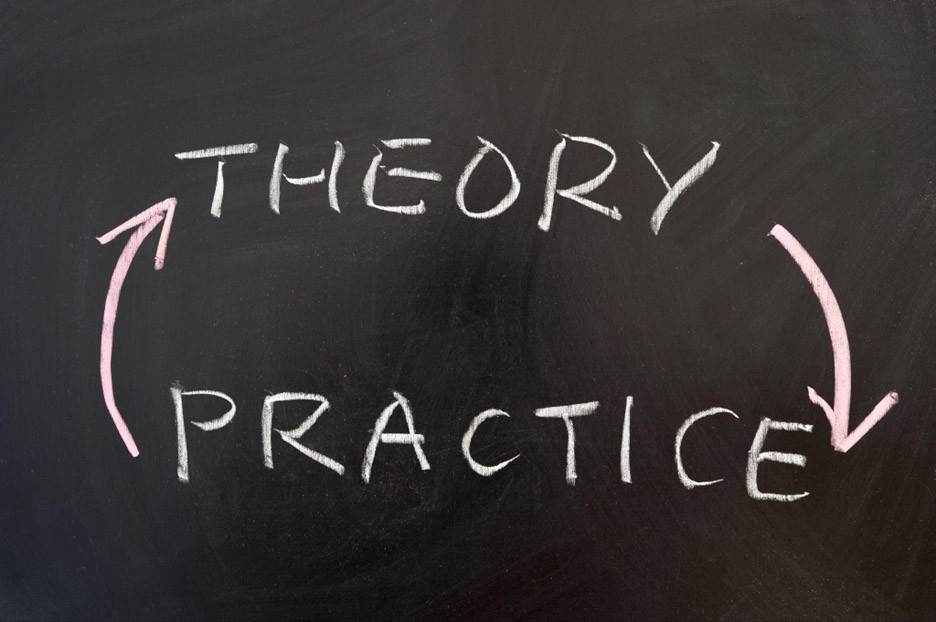🏢 9,000+ Organisations
🏆 6 x L&D/HR Awards
⭐ 4.8/5 Highly Rated
🧠 24 Years' Experience

A solid understanding of the latest theories on motivation is crucial for effective management training and leadership development.
It doesn’t matter if you’re a seasoned manager or a newcomer to your field. Understanding these concepts can significantly enhance your ability to inspire and engage your team members.
This blog will explore cutting-edge theories that have the potential to revolutionise approaches to motivation and drive exceptional results in organisations.

The evolution of motivation theories reflects a growing understanding of human behaviour and the factors that drive individuals to perform.
Early theories, such as Maslow’s Hierarchy of Needs, introduced the idea that motivation is influenced by a series of hierarchical needs. These range from basic physiological needs to more abstract ones like self-actualisation. This model emphasised the idea that individuals are motivated to fulfil lower-level needs before addressing higher-level ones.
In the mid-20th century, Hertzberg’s Two-Factor Theory expanded this understanding by differentiating between hygiene factors, which prevent dissatisfaction, and motivators, which enhance job satisfaction. This shift highlighted the importance of intrinsic factors in motivation.
As research progressed, Deci and Ryan’s Self-Determination Theory emerged, emphasising the role of autonomy, competence, and relatedness in supporting intrinsic motivation. This theory suggested that fulfilling these psychological needs would lead to greater engagement and well-being.
More recently, contemporary motivation models, such as the Goal-Setting Theory and the Expectancy Theory, have focused on the role of specific goals and expectations in driving motivation.
These evolving theories underscore the complexity of human motivation. They move from simple hierarchies to a nuanced understanding of psychological needs, external factors, and individual differences. They also provide valuable insights for leaders and organisations seeking to enhance employee motivation and develop new employee motivation strategies.
Leadership plays a crucial role in creating motivation within the workplace. It significantly influences employee engagement and productivity.
Effective leaders understand that motivation is not a one-size-fits-all approach. Instead, they recognise the diverse needs and aspirations of their team members. By adopting a personalised leadership style, leaders can create an environment where employees feel valued and understood.
One of the primary responsibilities of a leader is to communicate a clear vision and purpose. When employees understand how their work contributes to broader organisational goals, they are more likely to feel motivated to excel. Leaders who actively share this vision and provide regular feedback can instil a sense of ownership and accountability among team members.
Moreover, supportive leadership encourages an organisational culture of trust and open communication. Leaders who listen to their employees’ concerns and ideas create an inclusive atmosphere where individuals feel empowered to contribute. This involvement can significantly enhance intrinsic motivation, as employees are more engaged when they have a say in their work environment.
Recognition and reward also play a vital role in motivation. Leaders who celebrate achievements — both big and small — help reinforce positive behaviours and encourage ongoing effort. By creating opportunities for professional development and growth, leaders can further motivate employees to invest in their roles.
Ultimately, effective leadership is about inspiring and enabling team members to reach their full potential. By creating a positive workplace culture, communicating effectively, and recognising contributions, leaders can enhance motivation and drive overall organisational success.
The science of motivation and performance delves into the psychological and physiological factors that drive individuals to act and achieve their goals. Understanding this interplay is essential for optimising workplace productivity and employee satisfaction.
At its core, motivation can be divided into intrinsic and extrinsic motivation types.
Intrinsic motivation arises from within. It is driven by personal satisfaction, interest, or the desire to learn. It often leads to higher engagement and creativity.
In contrast, extrinsic motivation comes from external rewards, such as bonuses or recognition. While both types can enhance performance, research suggests that intrinsic motivation often results in more sustainable and satisfying outcomes.
Key theories in this field include Deci and Ryan’s Self-Determination Theory, which posits that fulfilling three basic psychological needs — autonomy, competence, and relatedness — enhances intrinsic motivation. When individuals feel a sense of control, mastery, and connection, they are more likely to be motivated and perform at their best.
Additionally, the Goal-Setting Theory highlights the importance of specific, measurable goals in driving performance. Clear goals provide direction and a sense of purpose, making individuals more focused and persistent.
Neuroscience also contributes to our understanding of motivation. Brain studies reveal that dopamine plays a significant role in reward processing, influencing motivation levels. When individuals anticipate rewards, dopamine release increases. This enhances their drive to pursue goals.
By integrating psychological theories of motivation and neuroscience, organisations can develop strategies to enhance performance and motivation. This ultimately leads to a more engaged and productive workforce.

Employers and leaders can utilise several different theories on motivation to encourage their team members and help them achieve their goals.
Here are some of the most noteworthy theories to keep in mind:
Self-Determination Theory (SDT), developed by Edward Deci and Richard Ryan, posits that human motivation is deeply influenced by the fulfilment of three innate psychological needs: autonomy, competence, and relatedness.
Autonomy refers to the need to feel in control of one’s actions and decisions. When individuals have the freedom to make choices, their intrinsic motivation flourishes.
Competence involves the need to feel effective in one’s activities. People are motivated to engage in tasks where they feel capable and can develop their skills.
Relatedness reflects the desire for social connections and belonging. Fulfilling this need creates collaboration and support within teams.
SDT emphasises the distinction between intrinsic and extrinsic motivation. Intrinsic motivation, driven by personal interest and enjoyment, leads to greater engagement and creativity, while extrinsic motivation, driven by external rewards, can undermine intrinsic motivation if overemphasised.
Organisations can apply SDT by creating environments that support autonomy through flexible work arrangements, promoting competence through skill development opportunities, and enhancing relatedness by strengthening a supportive workplace culture.
When these psychological needs are met, employees are more likely to experience enhanced motivation, well-being, and overall performance.
Goal-Setting Theory, introduced by Edwin Locke and Gary Latham, asserts that specific and challenging goals significantly enhance individual and team performance.
The theory suggests that when individuals have clear, well-defined goals, they are more likely to focus their efforts and persist in the face of challenges. Specific goals provide clarity, while challenging goals promote a sense of accomplishment when achieved.
The theory identifies several key principles for effective goal setting. First, goals should be specific and measurable, allowing individuals to track their progress. Second, goals should be challenging yet attainable, striking a balance that motivates individuals to push their limits without becoming discouraged. Additionally, feedback is crucial. It helps individuals understand their progress and adjust their efforts accordingly.
In practice, organisations can implement the Goal-Setting Theory by involving employees in the goal-setting process, ensuring that goals align with overall organisational objectives. Regular check-ins and feedback sessions can further reinforce motivation and keep employees engaged.
By creating a culture that values clear, ambitious goals, organisations can drive performance and encourage a sense of achievement among team members.
Discover other types of business goals to find what works best for your team and drive meaningful progress.
Expectancy Theory, formulated by Victor Vroom, posits that motivation is influenced by an individual’s expectations about the outcomes of their efforts. The theory is based on three key components: expectancy, instrumentality, and valence.
Expectancy refers to the belief that effort will lead to performance. If individuals feel that their efforts can indeed yield positive results, they are more motivated to act.
Instrumentality is the belief that performance will lead to specific outcomes or rewards. If employees believe that their hard work will be recognised or rewarded, their motivation increases.
Valence relates to the value individuals place on those outcomes. The more desirable the reward, the greater the motivation.
Organisations can leverage the Expectancy Theory by ensuring that employees perceive a clear link between their efforts and performance outcomes. This involves setting realistic performance standards and providing the necessary resources and support for employees to succeed. Additionally, clearly communicating the rewards for achieving goals can enhance the instrumentality aspect.
By understanding these dynamics, organisations can create a motivational environment that encourages employees to invest their efforts toward achieving desired outcomes.
Equity Theory, developed by John Stacey Adams, focuses on the balance between an employee’s input and the outcomes they receive compared to others.
The theory is grounded in the principle of fairness. Individuals assess their work effort in relation to the rewards they receive and compare this ratio to that of their peers. When individuals perceive inequity — whether they feel under-rewarded or over-rewarded — they experience feelings of dissatisfaction, which can impact their motivation and performance.
To maintain equity, organisations should ensure that rewards — such as salary, recognition, and career advancement — are fairly distributed based on employee contributions.
Open communication about how rewards are determined can help clarify perceived inequities. Additionally, creating a culture of recognition and appreciation can enhance feelings of fairness among employees.
When individuals believe they are treated equitably, they are more likely to be motivated, engaged, and committed to their work. This ultimately leads to higher overall performance within the organisation.
Reinforcement Theory, rooted in behavioural psychology and championed by B.F. Skinner, emphasises the role of reinforcement in shaping behaviour and motivation.
The theory posits that behaviours followed by positive consequences are likely to be repeated, while those followed by negative consequences are less likely to occur. This principle underlies the use of rewards and punishments in the workplace to influence employee behaviour.
Reinforcement can be categorised into positive reinforcement, where desirable outcomes are provided following a desired behaviour, and negative reinforcement, where undesirable outcomes are removed when a desired behaviour occurs.
Organisations can implement Reinforcement Theory by establishing clear behavioural expectations and consistently applying reinforcement strategies. For instance, recognising employees for their achievements or offering incentives for meeting performance goals can encourage desired behaviours.
However, it’s important for organisations to strike a balance in their reinforcement strategies. Over-reliance on external rewards can diminish intrinsic motivation. Therefore, combining reinforcement with opportunities for personal growth and intrinsic satisfaction can create a more holistic motivational approach. This will lead to sustained employee engagement and performance.

Modern motivation theories provide a valuable framework for enhancing employee engagement and performance in the workplace. By applying these theories, organisations can create an environment that supports motivation and drives success.
Self-Determination Theory (SDT) emphasises the importance of meeting employees’ psychological needs. Practical applications include:
For instance, organisations can implement mentorship programmes that encourage peer support and skill-sharing. As a result, they can enhance both competence and connection.
Goal-Setting Theory can be applied by establishing clear, specific, and challenging goals for teams and individuals.
Organisations should involve employees in the goal-setting process to ensure buy-in and ownership. Regular feedback sessions can also help track progress and adjust goals as needed.
This approach not only clarifies expectations but also motivates employees by celebrating milestones along the way.
Expectancy Theory highlights the need for a clear link between effort, performance, and rewards.
Organisations can enhance motivation by setting realistic performance metrics and ensuring that rewards — such as promotions, bonuses, or recognition — are clearly communicated. Transparency in how rewards are earned helps reinforce the belief that effort leads to meaningful outcomes.
Equity Theory can be addressed by promoting fairness in reward distribution. Organisations should regularly review compensation and recognition practices to ensure they are equitable. Creating channels for open dialogue about pay and performance can help mitigate feelings of inequity among employees.
Lastly, Reinforcement Theory can be employed through a structured reward system that includes both positive and negative reinforcement. Recognising and rewarding desired behaviours while providing constructive feedback for undesired behaviours can create a motivated workforce.

Implementing effective motivation techniques can be fraught with challenges, as organisations must manage a variety of factors that can hinder success. Here are some of the most well-known obstacles to keep in mind.
One of the primary challenges is the diverse nature of employee motivations.
People have varying intrinsic and extrinsic motivators, making it difficult to design a one-size-fits-all approach. For instance, while some employees may thrive on recognition and praise, others might prioritise autonomy or opportunities for professional growth.
This necessitates a tailored approach, which can be resource-intensive and complex to manage.
The existing culture within an organisation can significantly impact the effectiveness of motivation techniques.
If the culture does not support open communication, collaboration, or recognition, efforts to implement motivational strategies may fall flat. Employees may be sceptical of new initiatives if they perceive them as insincere or inconsistent with the organisation’s values.
Employees may resist new motivation techniques, particularly if they are accustomed to traditional methods. This resistance can stem from fear of the unknown or a lack of trust in leadership.
Overcoming this issue requires effective change management strategies, including clear communication about the benefits of new approaches and involving employees in the process.
Accurately measuring the impact of motivation techniques can be challenging. Organisations may struggle to collect relevant data and interpret it effectively, making it difficult to assess the success of implemented strategies. Moreover, without consistent feedback mechanisms, it’s challenging to adjust approaches based on employee responses.
Finally, maintaining motivation over the long term poses a challenge. Initial enthusiasm for new techniques can wane and lead to a drop in engagement. Organisations must continuously monitor and adapt their strategies to keep motivation levels high, which requires ongoing commitment and resources.
Understanding and applying modern motivation theories like those discussed above can significantly enhance workplace dynamics can support an environment where individuals feel valued, engaged, and driven to succeed.
To further develop these critical management skills, consider enrolling in management skills training at MTD Training.
This programme equips leaders with the tools they need to effectively motivate and engage their teams, ultimately driving organisational success. Additionally, for those looking for a more customised approach, in-house training for managers allows organisations to tailor their training to specific challenges and goals, ensuring that motivation techniques resonate with their unique workplace culture.
For individuals seeking to assess their personal and professional motivations, the Wheel of Life® Assessment can be an invaluable resource as well. This tool helps identify areas for growth and improvement, providing insights into how to enhance motivation in various aspects of life.
Embracing these resources can lead to more motivated teams and a more productive work environment. Invest in your leadership journey today and unlock the full potential of your organisation!

Written by Sean McPheat
CEO of MTD Training and Amazon bestselling author. Sean writes about leadership, business, and personal growth, drawing on 20+ years of experience helping over 9,000 companies improve performance.
Updated on: 16 January, 2025
Originally posted: 3 January 2012
Related Articles

Search For More 